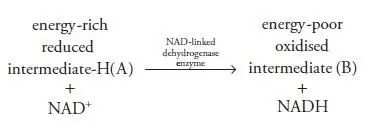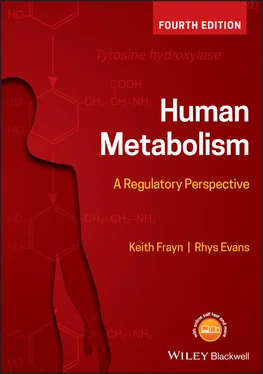1 ...8 9 10 12 13 14 ...24 
Oxygen is a powerful oxidising agent (the word ‘oxidising’ derives from oxygen) and is used in metabolism as an electron acceptor. Hydrogen is the reducing agent in many biological reactions and hence reduction could be termed ‘hydrogenation’ although this term has a specific meaning in chemistry, referring to the addition of hydrogen.
Oxidation and reduction are characterised by a change in the oxidation state of the atoms involved. The oxidation state is the (theoretical) charge (its electron status or ‘count’) that an atom would have if all its bonds were entirely ionic (not true in practice due to covalent bonding) – hence oxidation state denotes the degree of oxidation of an atom; it may be positive, zero, or negative, and an increase in oxidation state during a reaction denotes oxidation of the atom, whilst a decrease denotes reduction, both resulting from electron transfer. The tendency of an atom to attract electrons to itself (i.e. to act as an oxidising agent) is denoted by its electronegativity , and is partly a function of the distribution of its own (valence) electrons; by contrast, the tendency of an atom to donate electrons (i.e. to act as a reducing agent) is denoted by its electropositivity .
The chemically usable energy in a biomolecule which is a metabolic substrate is therefore present in the form of electrons, and therefore electron-rich molecules will be energy-rich and serve as good energy sources for metabolism. All three major metabolic substrate groups – carbohydrates, lipids, and proteins – contain these electrons in association with carbon-hydrogen (C–H) bonds. They can all be thought of as reduced (electron-rich) carbon (as found in wood, coal, house gas, and heating oil). In energy-yielding metabolism they act as reducing agents, donating these electrons to an electron acceptor, and ultimately themselves getting oxidised (the carbon ending up fully oxidised as CO 2and the hydrogen as H 2O). The ultimate electron acceptor (oxidising agent) is, of course, oxygen.
e.g.

This demonstrates the importance of oxygen in metabolism: a strong electron acceptor is required to permit adequate electron transfer (and energy yield) from energy-rich substrates to occur, the difference in free energy levels between the tendency of the reducing agent to donate electrons and of the oxidising agent to accept electrons representing the energy yield of the overall process. (This may be contrasted with fermentation reactions which do not involve net reduction-oxidation, for example glycolysis of glucose to lactate: the energy yield is too small to sustain mammalian energy requirements and the substrate must be oxidised to maximise energy yield.) It can also be seen that lipids (e.g. fatty acids: CH 3(CH 2)n·COOH, where n is typically 12–16, Figure 1.4) are far more reduced (C–H bond-rich; electron-rich) than carbohydrates (e.g. glucose C 6H 12O 6), in which the carbon atoms are already partially oxidised, with fewer C–H bonds and therefore fewer energy-rich electrons to donate, and hence lipids contain far more energy (per gram) than carbohydrates. Amino acids are comparable to carbohydrates in the state of reduction of their carbon atoms, and hence of their energy content.
However, if electrons were transferred directly from substrate (e.g. glucose, fatty acid) to oxygen, the large energy yield would be uncontrollable. Therefore, a long series of intermediary electron transfer (redox) reactions occur in which energy-rich e −is transferred sequentially and incrementally down a gradually decreasing (free) energy gradient. This explains why metabolic pathways are relatively long with many steps: small amounts only of energy are given off at each step. The energy (electron) extracted is then conveyed by electron carriers. Examples of electron carriers are NAD +, NADP +, and FAD. These are of course redox compounds themselves, accepting electrons (in the form of hydride ions H −, i.e. a hydrogen atom with the extra, energy-carrying electron) from the metabolic pathway (becoming reduced – e.g. NADH; NADPH; FADH 2) and passing them on (becoming re-oxidised) to further carriers at sequentially lower energy levels (electron transport chain redox proteins) until ultimately oxygen accepts the electrons, becoming itself reduced to water. It is for this reason that many key energy-yielding reactions in metabolic pathways are catalysed by dehydrogenase enzymes linked to transfer of a hydride ion H −to the hydride acceptor NAD +:

The redox state of a cell refers to the proportion of these intermediary electron carriers that are in the reduced (high energy) state compared to those in the oxidised (low energy) form: the NAD +: NADH ratio for example provides an estimate of the energetic ‘charge’ (potential) contained within the cell (in an analogous fashion to the phosphorylation potential denoting the amount of adenine nucleotide in the form of ATP) – it is for this reason that many metabolic pathways are regulated not only by the phosphorylation potential ([ATP]: [ADP] and [AMP]) but, as we are increasingly recognising, also by the redox potential (NAD +: NADH; NADP +:NADPH).
1.2.2 The chemical characteristics of macronutrients
1.2.2.1 Carbohydrates
Simple carbohydrates have the empirical formula C n(H 2O) n; complex carbohydrates have an empirical formula which is similar to this (e.g. C n(H 2O) 0.8n). The name carbohydrate reflects the idea, based on this empirical formula, that these compounds are hydrates of carbon. It is not strictly correct but illustrates an important point about this group of compounds – the relative abundance of hydrogen and oxygen, in proportions similar to those in water, in their molecules. From the discussion above, it will be apparent that carbohydrates are mostly relatively polar molecules, miscible with, or soluble in, water. Carbohydrates in nature include the plant products starch and cellulose and the mammalian storage carbohydrate glycogen (‘animal starch’), as well as various simple sugars, of which glucose is the most important from the point of view of human metabolism. The main source of carbohydrate we eat is the starch in vegetables such as potatoes, rice, and grains.
The chemical definition of a sugar is that its molecules consist of carbon atoms, each bearing one hydroxyl group (–OH), except that one carbon bears a carbonyl group (=O) rather than a hydroxyl. In solution, the molecule exists in equilibrium between a ‘straight-chain’ form and a ring structure, but as the ring structure predominates sugars are usually shown in this form ( Figure 1.7). Nevertheless, some of the chemical properties of sugars can only be understood by remembering that the straight-chain form exists. The basic carbohydrate unit is known as a monosaccharide. Monosaccharides may have different numbers of carbon atoms, and the terminology reflects this: thus, a hexose has six carbon atoms in its molecule, a pentose five, and so on. Pentoses and hexoses are the most important in terms of mammalian metabolism. These sugars also have ‘common names’ which often reflect their natural occurrence. The most abundant in our diet and in our bodies are the hexoses glucose (grape sugar, named from the Greek γλυκύς [ glykys ] sweet), fructose (fruit sugar, from the Latin fructus for fruit), and galactose (derived from lactose, milk sugar; from the Greek γαλακτος [ galaktos ], milk), and the pentose ribose , a constituent of nucleic acids (the name comes from the related sugar arabinose, named from Gum arabic ).
Читать дальше















